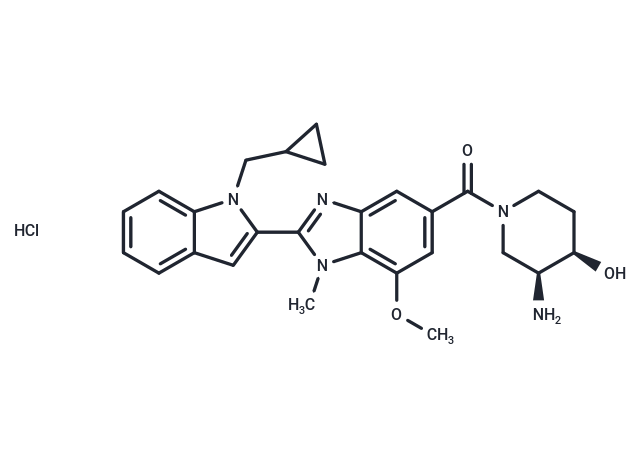Shopping Cart
- Remove All
 Your shopping cart is currently empty
Your shopping cart is currently empty

GSK484 hydrochloride (GTPL8577) is a reversible peptidyl-arginine deiminase 4 (PAD4) inhibitor. It binds to PAD4 with high affinity, with IC50 of 250 and 50 nM in the presence and absence of 2 mM calcium, respectively. GSK484 promotes the radiosensitivity of colorectal cancer (CRC) and inhibits NET formation in vitro and in vivo.

| Pack Size | Price | Availability | Quantity |
|---|---|---|---|
| 1 mg | $68 | In Stock | |
| 5 mg | $158 | In Stock | |
| 10 mg | $239 | In Stock | |
| 25 mg | $482 | In Stock | |
| 50 mg | $689 | In Stock | |
| 100 mg | $982 | In Stock | |
| 1 mL x 10 mM (in DMSO) | $176 | In Stock |
| Description | GSK484 hydrochloride (GTPL8577) is a reversible peptidyl-arginine deiminase 4 (PAD4) inhibitor. It binds to PAD4 with high affinity, with IC50 of 250 and 50 nM in the presence and absence of 2 mM calcium, respectively. GSK484 promotes the radiosensitivity of colorectal cancer (CRC) and inhibits NET formation in vitro and in vivo. |
| Targets&IC50 | PAD4:50 nM (in 0 mM Calcium), PAD4:50 nM (in 2 mM Calcium) |
| In vitro | METHODS: GSK484 hydrochloride (GTPL8577) (10 μM) treated mouse and human neutrophils, demonstrating inhibition of citrullination by Western blot and novel imaging assays in neutrophils stimulated with calcium ionophore or bacteria and further Study the effects on NET formation in vitro by mouse and human neutrophils. RESULTS GSK484 hydrochloride pretreatment significantly reduced citrulline production and NET formation. [1] |
| In vivo | To determine if PAD4 inhibition can mitigate cancer-associated kidney damage, MMTV-PyMT mice received the PAD4 inhibitor GSK484 at a dosage of 4 mg/kg daily for one week. This treatment effectively lowered the elevated neutrophil NETosis in the peripheral blood of cancerous mice. Concurrently, there was a significant reduction in the urine protein level of treated MMTV-PyMT mice compared to those untreated, indicating kidney function improvement akin to that achieved with DNase I treatment, without any observed toxicity [2]. |
| Kinase Assay | PAD4 is serially diluted in the presence of 10 nM GSK215 in assay buffer (100 mM HEPES, pH 8, 50 mM NaCl, 5% glycerol, 1 mM CHAPS, 1 mM DTT) at varying concentrations of calcium (0, 0.2, 2 and 10 mM). Following incubation for 50 min, apparent Kds for each calcium concentration are determined using a single site saturation curve. For IC50 determination, GSK484 is serially diluted in DMSO (1% final assay concentration) and tested at the same range of calcium concentrations in the presence of PAD4 (at the calculated Kd for each calcium condition) and 10 nM GSK215 in the same assay buffer and volume. Reactions are incubated for 50 min after which IC50 values are calculated using a four-parameter logistic equation [1]. |
| Cell Research | HEK293 cells stably expressing N-terminal FLAG-tagged PAD1, PAD2, PAD3 or PAD4 are engineered by retroviral transduction. Cells are grown in 15 cm diameter plates to subconfluency in DMEM supplemented with 10% Foetal Bovine Serum, harvested by centrifugation and washed once in PBS/2 mM EGTA. Cells are lysed in 50 mM Tris-Cl, pH 7.4, 1.5 mM MgCl2, 5% glycerol, 150 mM NaCl, 25 mM NaF, 1 mM Na3VO4, 0.4% NP40, 1 mM DTT with protease inhibitors. Lysates are pre-incubated for 20 min at 4°C with DMSO alone (2%), 100 μM of GSK199, GSK484, GSK106 or 200 μM Cl-amidine. Citrullination reactions are performed for 30 min at 37°C in the presence of 2 mM calcium. Extracts are loaded on to gels, proteins separated by SDS-PAGE and transferred to PVDF membranes. Citrullinated proteins are then chemically modified and detected using an anti-modified citrulline antibody. FLAG-PAD constructs are detected using the anti-FLAG antibody [1]. |
| Animal Research | The study includes the MMTV-PyMT mouse model for mammary carcinoma (FVB/n background) and the RIP1-Tag2 mouse model for pancreatic neuroendocrine carcinoma (C57BL/6 background). Mice are treated daily by intra-peritoneal injections of the PAD4 inhibitor GSK484 (4 mg/kg). GSK484 is dissolved in 99.9% ethanol at a concentration of 25 mg/mL to generate a stock solution and further diluted 1:50 in 0.9% NaCl shortly before injection of 200 μL/mouse [2]. |
| Alias | GTPL8577, AOB6992 |
| Molecular Weight | 510.03 |
| Formula | C27H32ClN5O3 |
| Cas No. | 1652591-81-5 |
| Smiles | Cl.COc1cc(cc2nc(-c3cc4ccccc4n3CC3CC3)n(C)c12)C(=O)N1CC[C@@H](O)[C@@H](N)C1 |
| Relative Density. | no data available |
| Storage | Powder: -20°C for 3 years | In solvent: -80°C for 1 year | Shipping with blue ice. | ||||||||||||||||||||||||||||||||||||||||
| Solubility Information | H2O: 100 mg/mL (196.07 mM), Sonication is recommended. PBS: <1 mg/mL (insoluble or slightly soluble) DMSO: 45 mg/mL (88.23 mM), Sonication is recommended. | ||||||||||||||||||||||||||||||||||||||||
Solution Preparation Table | |||||||||||||||||||||||||||||||||||||||||
DMSO/H2O
H2O
| |||||||||||||||||||||||||||||||||||||||||

Copyright © 2015-2025 TargetMol Chemicals Inc. All Rights Reserved.